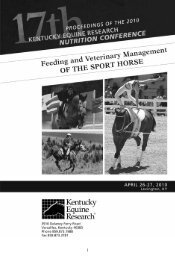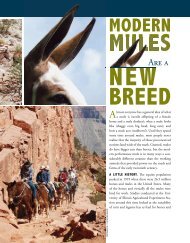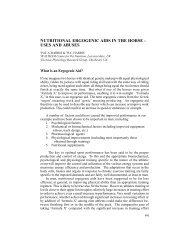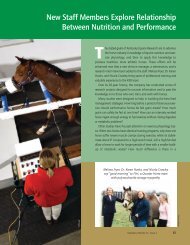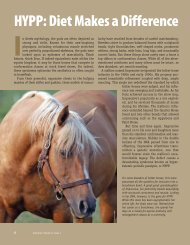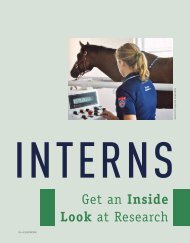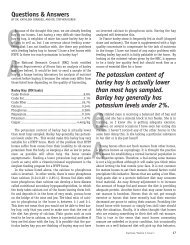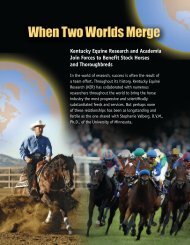Understanding Digestion in the Horse, A Comparative Approach
Understanding Digestion in the Horse, A Comparative Approach
Understanding Digestion in the Horse, A Comparative Approach
You also want an ePaper? Increase the reach of your titles
YUMPU automatically turns print PDFs into web optimized ePapers that Google loves.
<strong>Understand<strong>in</strong>g</strong> <strong>Digestion</strong> <strong>in</strong> <strong>the</strong> <strong>Horse</strong>,<br />
A <strong>Comparative</strong> <strong>Approach</strong><br />
6 Equ<strong>in</strong>ews/ Volume 10, Issue 3<br />
Have you ever considered <strong>the</strong> gastro<strong>in</strong>test<strong>in</strong>al tract of <strong>the</strong> mouse-chas<strong>in</strong>g tabby that skulks<br />
around your stable? Ever thought about how market hogs derive energy from <strong>the</strong>ir diets of corn<br />
and soybeans? Does a three-ton elephant really have anyth<strong>in</strong>g <strong>in</strong> common with your horse,<br />
digestive or o<strong>the</strong>rwise?<br />
In today’s highly specialized world, animal nutritionists tend to consider <strong>the</strong>mselves specialists <strong>in</strong><br />
ei<strong>the</strong>r rum<strong>in</strong>ant or nonrum<strong>in</strong>ant nutrition. Rum<strong>in</strong>ant nutritionists appreciate <strong>the</strong> significance fermentation<br />
plays <strong>in</strong> meet<strong>in</strong>g <strong>the</strong> nutritional components of animals with multiple stomachs, but <strong>the</strong>y<br />
tend to th<strong>in</strong>k of most nonrum<strong>in</strong>ants as “simple-gutted.” Nonrum<strong>in</strong>ant nutritionists, conversely, often<br />
dismiss <strong>the</strong> importance of microbial fermentation to <strong>the</strong> health and well-be<strong>in</strong>g of <strong>the</strong> animal. These<br />
are critical oversights, because fermentation plays a key role <strong>in</strong> <strong>the</strong> nutritional ecology of almost<br />
every species of animal <strong>in</strong>clud<strong>in</strong>g horses.<br />
Therefore, a basic understand<strong>in</strong>g of <strong>the</strong> function fermentation plays <strong>in</strong> a wide range of species is<br />
critical when consider<strong>in</strong>g its importance <strong>in</strong> <strong>the</strong> horse. An appreciation of <strong>the</strong> cont<strong>in</strong>uity of microbial<br />
fermentation across several species allows <strong>in</strong>formation ga<strong>the</strong>red <strong>in</strong> one species to be used for <strong>the</strong><br />
benefit of o<strong>the</strong>r species.<br />
<strong>Digestion</strong> of Carbohydrates<br />
In order to understand <strong>the</strong> significance of fermentation <strong>in</strong> animal digestion, a brief explanation of<br />
carbohydrate digestion is needed. The digestion of starch occurs primarily though <strong>the</strong> work of<br />
enzymes <strong>in</strong> <strong>the</strong> small <strong>in</strong>test<strong>in</strong>e. In terms of equ<strong>in</strong>e feed management, sources of starch are usually<br />
cereal gra<strong>in</strong>s such as oats, barley, and corn. The f<strong>in</strong>al product of starch digestion is chiefly glucose.<br />
Though most starch digestion occurs <strong>in</strong> <strong>the</strong> small <strong>in</strong>test<strong>in</strong>e through enzymatic action, m<strong>in</strong>imal fermentation<br />
of starch occurs <strong>in</strong> <strong>the</strong> stomach and portions of <strong>the</strong> large <strong>in</strong>test<strong>in</strong>e (<strong>the</strong> cecum and <strong>the</strong><br />
colon). The end products of starch fermentation <strong>in</strong> <strong>the</strong> large <strong>in</strong>test<strong>in</strong>e are volatile fatty acids (VFAs)<br />
and lactic acid.<br />
In contrast to starch, plant fiber is digested entirely by fermentation, which results <strong>in</strong> <strong>the</strong><br />
production of VFAs. Fermentation of plant fiber occurs <strong>in</strong> <strong>the</strong> h<strong>in</strong>dgut of <strong>the</strong> horse. Not all<br />
animals are anatomically similar to horses. O<strong>the</strong>rs possess dist<strong>in</strong>ctive digestive tracts that<br />
determ<strong>in</strong>e where fermentation takes place.<br />
Four Basic Digestive Systems<br />
Animals can be divided <strong>in</strong>to three basic groups accord<strong>in</strong>g to <strong>the</strong> structure of <strong>the</strong>ir gastro<strong>in</strong>test<strong>in</strong>al<br />
anatomy and its ability to ferment feedstuffs. First, animals can be classified as<br />
ei<strong>the</strong>r pregastric fermenters or h<strong>in</strong>dgut fermenters based on <strong>the</strong> primary location of microbial fermentation<br />
<strong>in</strong> relation to <strong>the</strong> stomach.
Pregastric fermenters are <strong>the</strong>n subdivided <strong>in</strong>to rum<strong>in</strong>ants or nonrum<strong>in</strong>ants. Common rum<strong>in</strong>ants<br />
are cattle, sheep, goats, deer, antelope, and camels. These animals have highly<br />
developed digestive tracts that use fermentation to degrade feedstuffs. Large, multicompartment<br />
stomachs selectively sort and reta<strong>in</strong> plant fiber for extended periods of time.<br />
Digesta <strong>the</strong>n moves to <strong>the</strong> animal’s “true stomach,” hence <strong>the</strong> adjective “pregastric.”<br />
Nonrum<strong>in</strong>ants <strong>in</strong> this category <strong>in</strong>clude hamsters, voles, kangaroos, and hippopotamuses.<br />
H<strong>in</strong>dgut fermenters are also split <strong>in</strong>to two classifications accord<strong>in</strong>g to whe<strong>the</strong>r <strong>the</strong>y<br />
depend primarily on <strong>the</strong> cecum or colon for microbial digestion. Cecal fermenters <strong>in</strong>clude rabbits,<br />
gu<strong>in</strong>ea pigs, ch<strong>in</strong>chillas, and rats.<br />
Large nonrum<strong>in</strong>ant herbivores such as horses, rh<strong>in</strong>oceroses, gorillas, and elephants depend more<br />
on <strong>the</strong> colon for microbial fermentation. Omnivores such as pigs and man have sacculated colons<br />
where a good deal of digestion takes place. Carnivores such as cats and dogs have little or no cecal<br />
capacity and an unsacculated colon.<br />
Adaptations for Microbial Fermentation<br />
In order for microbial fermentation to be useful, animals must have digestive systems that can<br />
reta<strong>in</strong> digesta and microorganisms for a long period of time while simultaneously ma<strong>in</strong>ta<strong>in</strong><strong>in</strong>g an<br />
environment suitable for fermentation of plant material. The degree <strong>in</strong> which a particular species<br />
is able to use fermentation will depend primarily on three factors: (1) <strong>the</strong> total volume available<br />
for fermentation <strong>in</strong> <strong>the</strong> digestive tract, (2) <strong>the</strong> retention time of <strong>in</strong>gested material, and (3) <strong>the</strong><br />
makeup of <strong>the</strong> microbial population <strong>in</strong>habit<strong>in</strong>g <strong>the</strong> h<strong>in</strong>dgut.<br />
Volume available for fermentation. The importance of microbial fermentation as a means of digestion<br />
<strong>in</strong> various species can be demonstrated by <strong>the</strong> proportion of <strong>the</strong> digestive tract devoted to<br />
fermentation. Rum<strong>in</strong>ants typically allocate <strong>the</strong> largest proportion of <strong>the</strong>ir digestive tracts to fermentation.<br />
Nearly 75% of <strong>the</strong> bov<strong>in</strong>e digestive tract, for <strong>in</strong>stance, is suitable for support<strong>in</strong>g microbial<br />
fermentation. The vast majority of this fermentation capacity is <strong>in</strong> <strong>the</strong> reticulum and rumen, two<br />
compartments of <strong>the</strong> stomach. Nonrum<strong>in</strong>ant herbivores such as horses tend to dedicate a smaller<br />
proportion of <strong>the</strong>ir total digestive capacity to fermentation. Both rum<strong>in</strong>ant and nonrum<strong>in</strong>ant grazers<br />
such as horses and cows usually have more developed digestive tracts than selective herbivores like<br />
rabbits and hamsters.<br />
Omnivores vary greatly <strong>in</strong> <strong>the</strong>ir fermentation capacity. For example, pigs have a volum<strong>in</strong>ous<br />
h<strong>in</strong>dgut account<strong>in</strong>g for about 48% of <strong>the</strong>ir total digestive capacity, but humans devote only<br />
approximately 17% of <strong>the</strong>ir tracts to microbial fermentation. As mentioned previously, carnivores<br />
usually have unsacculated colons that represent a small proportion of total digestive capacity.<br />
Table 1 compares <strong>the</strong> fermentive capacities of specific organs <strong>in</strong> n<strong>in</strong>e species. Rum<strong>in</strong>ants (cattle<br />
and sheep) use more of <strong>the</strong>ir digestive tract for fermentation than horses.<br />
Retention time. The extent to which plant material is fermented depends on how long it is <strong>in</strong> contact<br />
with <strong>the</strong> microbes. Longer retention results <strong>in</strong> more complete digestion, but <strong>the</strong>re is a limit to<br />
<strong>the</strong> total amount of time <strong>the</strong> material can be subjected to fermentation before energy production<br />
becomes compromised. Herbivores such as horses depend to a large degree on volatile fatty acids<br />
(VFAs) as a source of dietary energy. These VFAs are by-products of microbial fermentation. If digesta<br />
is reta<strong>in</strong>ed too long <strong>in</strong> <strong>the</strong> fermentive organs, VFAs will be degraded by certa<strong>in</strong> anaerobic<br />
microorganisms, thus depriv<strong>in</strong>g horses of energy.<br />
As rum<strong>in</strong>ants become larger, mean retention time <strong>in</strong>creases. Buffaloes, which at maturity have a<br />
body weight of about 2200 pounds (1000 kg), have retention times of between 90 and 100 hours.<br />
Retention times longer than this would make animals susceptible to <strong>the</strong> aforementioned degradation.<br />
Equ<strong>in</strong>ews/Volume 10, Issue 3 7
um<strong>in</strong>ant – an animal with a<br />
four-chambered stomach that<br />
regurgitates partially digested<br />
food (called cud) for fur<strong>the</strong>r<br />
chew<strong>in</strong>g and reswallow<strong>in</strong>g<br />
nonrum<strong>in</strong>ant – an animal with<br />
a s<strong>in</strong>gle-chambered stomach<br />
fermentation – <strong>the</strong> energyyield<strong>in</strong>g<br />
metabolic breakdown<br />
of nutrients <strong>in</strong> a no-oxygen<br />
environment<br />
herbivore – an animal that<br />
eats primarily plants<br />
omnivore – an animal that<br />
eats plants and o<strong>the</strong>r animals<br />
carnivore – an animal that<br />
eats o<strong>the</strong>r animals<br />
sacculated –characterized by<br />
a series of saclike pouches<br />
or expansions<br />
unsacculated – smooth<br />
membrane with no bunch<strong>in</strong>g,<br />
ridges, or pouches<br />
digesta – feedstuffs <strong>in</strong><br />
various phases of digestion<br />
as <strong>the</strong>y flow through <strong>the</strong><br />
gastro<strong>in</strong>test<strong>in</strong>al tract<br />
foregut – a collective term<br />
for <strong>the</strong> stomach and<br />
small <strong>in</strong>test<strong>in</strong>e<br />
h<strong>in</strong>dgut – <strong>the</strong> large <strong>in</strong>test<strong>in</strong>e,<br />
<strong>in</strong>clud<strong>in</strong>g <strong>the</strong> cecum and colon<br />
microflora – bacterial colonies<br />
found <strong>in</strong> <strong>the</strong> large <strong>in</strong>test<strong>in</strong>e<br />
8 Equ<strong>in</strong>ews/ Volume 10, Issue 3<br />
Table 1. Fermentive capacity expressed as percentage of total digestive tract. 1<br />
Reticulum and<br />
Species Rumen (Stomach) Cecum Colon and Rectum Total Fermentive<br />
Cow 64 5 5-8 73<br />
Sheep 71 8 4 83<br />
<strong>Horse</strong> — 15 54 69<br />
Pig — 15 54 69<br />
Gu<strong>in</strong>ea pig — 71 9 80<br />
Rabbit — 43 8 51<br />
Human – – 17 17<br />
Cat – – 16 16<br />
Dog — 1 13 14<br />
1 Parra, R. 1978. Comparison of foregut and h<strong>in</strong>dgut fermentation <strong>in</strong> herbivores. In: Ecology of Arboreal Folivores. G.G.<br />
Montgomery, Ed. Smithsonian Institute Press, Wash<strong>in</strong>gton, D.C.<br />
Animals larger than 2200 pounds must <strong>the</strong>refore employ a digestive system that is different than<br />
<strong>the</strong> rum<strong>in</strong>ant to allow for rapid digesta transit, which <strong>in</strong> turn supports optimal microbial fermentation.<br />
Elephants and rh<strong>in</strong>oceroses are h<strong>in</strong>dgut fermenters with digesta transit times that are much<br />
faster than rum<strong>in</strong>ants. These massive mammals have adopted <strong>the</strong> dietary strategy of <strong>in</strong>gest<strong>in</strong>g<br />
large quantities of dry matter and pass<strong>in</strong>g it through <strong>the</strong> digestive system fairly quickly. Any loss of<br />
digestive efficiency is offset by <strong>in</strong>creased <strong>in</strong>take. In general, <strong>the</strong> larger <strong>the</strong> h<strong>in</strong>dgut fermenter, <strong>the</strong><br />
more rapid digesta transit.<br />
A notable exception to <strong>the</strong> relationship between body size and transit rate <strong>in</strong> nonrum<strong>in</strong>ants is <strong>the</strong><br />
giant panda. These animals are actually carnivores that have evolved to survive on a diet of bamboo.<br />
They have simple, short digestive tracts with little volume to accommodate microbial<br />
fermentation, yet <strong>the</strong>y live <strong>in</strong> <strong>the</strong> wild as herbivores. Researchers determ<strong>in</strong>ed <strong>the</strong> rate of passage<br />
and digestibility <strong>in</strong> giant pandas. These data, along with digestibility data from elephants and horses,<br />
are shown <strong>in</strong> Table 2. The giant pandas were fed bamboo and gruel diets, while <strong>the</strong> elephants<br />
and horses were fed grass hay.<br />
The horses and elephants <strong>in</strong> <strong>the</strong>se studies ate 1.5% of <strong>the</strong>ir body weight per day <strong>in</strong> hay, while <strong>the</strong><br />
giant pandas consumed 4.3% of <strong>the</strong>ir body weight. The pandas have adopted a dietary strategy of<br />
Table 2. <strong>Comparative</strong> digestion and passage between giant pandas, horses, and elephants.<br />
Giant pandas <strong>Horse</strong>s Elephants<br />
Body weight (kg) 119 500 2714<br />
Intake (% of body weight) 4.3 1.5 1.5<br />
Mean retention (hours) 8 30 24<br />
Digestibility (%)<br />
Dry matter 20 50 41<br />
Prote<strong>in</strong> 90 55 50<br />
Cellulose 84 84 2<br />
Hemicellulose 27 53 44
extremely high <strong>in</strong>take and short retention time. Although <strong>the</strong><br />
panda’s diet of bamboo is high <strong>in</strong> fiber, digestibility of fiber is<br />
quite low. Instead, pandas extract <strong>the</strong> cell contents from <strong>the</strong><br />
bamboo, and <strong>the</strong> animals depend very little on microbial fermentation.<br />
Prote<strong>in</strong> digestibility was 90% from <strong>the</strong> bamboo<br />
because most of <strong>the</strong> prote<strong>in</strong> <strong>in</strong> bamboo is located with<strong>in</strong> <strong>the</strong> cell<br />
contents ra<strong>the</strong>r than <strong>in</strong> <strong>the</strong> cell wall.<br />
<strong>Horse</strong>s and elephants illustrate <strong>the</strong> general trend <strong>in</strong> rate of<br />
passage and digestibility <strong>in</strong> large nonrum<strong>in</strong>ant herbivores as it<br />
relates to body size. <strong>Horse</strong>s have a rate of passage equal to about<br />
30 hours, and <strong>the</strong>y digest about 50% of <strong>the</strong> dry matter <strong>in</strong> hay.<br />
Elephants, conversely, have a shorter retention time, about 24<br />
hours, and lower dry matter digestibility. Fiber and prote<strong>in</strong><br />
digestibilities follow <strong>the</strong> same trend.<br />
Microbial populations <strong>in</strong> different species. Although animals<br />
vary greatly <strong>in</strong> <strong>the</strong>ir dependence on microbial fermentation, <strong>the</strong><br />
populations of microbes that <strong>in</strong>habit <strong>the</strong> organs utilized for fermentation<br />
and <strong>the</strong> environments with<strong>in</strong> <strong>the</strong>se organs are<br />
remarkably similar.<br />
Despite <strong>the</strong> fact that pigs, dogs, and ponies vary tremendously<br />
<strong>in</strong> <strong>the</strong>ir dependence on microbial digestion, <strong>the</strong>y all have h<strong>in</strong>dgut<br />
environments conducive to fermentation. While VFA concentrations<br />
are high <strong>in</strong> <strong>the</strong> large <strong>in</strong>test<strong>in</strong>e of each of <strong>the</strong>se species, pigs<br />
and dogs have higher colonic VFA concentrations than ponies.<br />
This shows that species that are normally thought of as monogastrics<br />
have active sites of fermentation <strong>in</strong> <strong>the</strong>ir large <strong>in</strong>test<strong>in</strong>es.<br />
Pigs are quite capable of utiliz<strong>in</strong>g high-fiber diets, though<br />
this fact has been largely ignored as <strong>in</strong>tensive sw<strong>in</strong>e management<br />
programs have developed. These days, pigs are often<br />
kept <strong>in</strong> conf<strong>in</strong>ement and fed high-starch diets that conta<strong>in</strong> significant<br />
amounts of corn. In <strong>the</strong>ir classic animal husbandry<br />
text, Feeds and Feed<strong>in</strong>g (N<strong>in</strong>eteenth Edition), Henry and<br />
Morrison state, “Pastures are so important to pork production<br />
that <strong>the</strong>y often make all <strong>the</strong> difference between profit and<br />
loss. Few facts <strong>in</strong> sw<strong>in</strong>e feed<strong>in</strong>g have been so clearly proven,<br />
both by scientific experiments and <strong>in</strong> <strong>the</strong> common experience<br />
of successful farmers, as <strong>the</strong> high value of pasture or forage<br />
crops for all classes of sw<strong>in</strong>e.”<br />
In horses <strong>the</strong> microflora <strong>in</strong> <strong>the</strong> h<strong>in</strong>dgut are susceptible to diets<br />
that veer severely from primarily forage. A close look at starch,<br />
which is abundant <strong>in</strong> cereal gra<strong>in</strong>s such as corn, barley, and oats,<br />
proves that it is a versatile energy source. However, problems arise<br />
when it is overfed. Studies at Kentucky Equ<strong>in</strong>e Research (KER)<br />
have shown that pH of <strong>the</strong> h<strong>in</strong>dgut drops significantly <strong>in</strong> horses<br />
follow<strong>in</strong>g a gra<strong>in</strong> meal rich <strong>in</strong> starch, with <strong>the</strong> lowest po<strong>in</strong>t occurr<strong>in</strong>g<br />
between four and eight hours after feed<strong>in</strong>g. Changes <strong>in</strong><br />
h<strong>in</strong>dgut pH make horses susceptible to colic and lam<strong>in</strong>itis. For<br />
this reason and o<strong>the</strong>rs, KER nutritionists generally recommend<br />
gra<strong>in</strong> meals be small, generally not exceed<strong>in</strong>g five pounds.<br />
For horses that must consume large quantities of gra<strong>in</strong> <strong>in</strong> order<br />
to fuel exercise or ma<strong>in</strong>ta<strong>in</strong> body weight, a h<strong>in</strong>dgut buffer such as<br />
KER’s EquiShure is appropriate because it steadies <strong>the</strong> pH, prevent<strong>in</strong>g<br />
sudden downward shifts that could harm microflora.<br />
Interspecies Comparisons<br />
A constant source of debate among animal nutritionists is<br />
whe<strong>the</strong>r <strong>in</strong>formation from one species can be used to improve <strong>the</strong><br />
way o<strong>the</strong>r species are fed. Are data ga<strong>the</strong>red from rum<strong>in</strong>ants relevant<br />
to horses? Are data ga<strong>the</strong>red from horses transferable to<br />
pigs? In light of <strong>the</strong> similarities between microbial fermentation<br />
across many species, <strong>the</strong> answer would appear to be yes.<br />
One example of this <strong>in</strong>volves yeast culture. Early work with<br />
rum<strong>in</strong>ants showed that yeast culture affected microbial fermentation<br />
<strong>in</strong> a number of beneficial ways. Initially, nonrum<strong>in</strong>ant<br />
nutritionists dismissed this <strong>in</strong>formation as unimportant for monogastric<br />
animals primarily because <strong>the</strong> rumen was deemed an<br />
<strong>in</strong>appropriate model for rabbits, pigs, or horses. Research with<br />
rabbits and horses, <strong>in</strong>clud<strong>in</strong>g some conducted at KER, showed<br />
that yeast culture affects <strong>the</strong> <strong>in</strong>test<strong>in</strong>al microbes <strong>in</strong> <strong>the</strong>se species<br />
<strong>in</strong> much <strong>the</strong> same way that rumen microflora are affected.<br />
Transfer of <strong>in</strong>formation across species is important for <strong>the</strong> wellbe<strong>in</strong>g<br />
of all animals. An open-m<strong>in</strong>ded approach to feed<strong>in</strong>g often<br />
yields benefits for multiple species.<br />
Microbial fermentation is important for most animals. The<br />
anatomical adaptations that each species has developed depend<br />
primarily on body size and natural diet. The total volume of <strong>the</strong><br />
digestive tract devoted to fermentation and <strong>the</strong> amount of time<br />
digesta spends <strong>in</strong> <strong>the</strong>se organs varies greatly from species to<br />
species. The types of microflora that <strong>in</strong>habit <strong>the</strong> digestive tracts of<br />
various animals, however, are similar. Thus, it would seem logical<br />
that dietary manipulations that affect one species may also<br />
affect o<strong>the</strong>r species if <strong>the</strong> differences that exist between <strong>in</strong>test<strong>in</strong>al<br />
architecture are taken <strong>in</strong>to account.<br />
When research<strong>in</strong>g feeds and feed<strong>in</strong>g practices for horses,<br />
KER nutritionists look beyond research conducted on horses. By<br />
cast<strong>in</strong>g a wider net and look<strong>in</strong>g at <strong>the</strong> research performed <strong>in</strong><br />
o<strong>the</strong>r species, KER feed formulators ma<strong>in</strong>ta<strong>in</strong> <strong>the</strong>ir scientific<br />
advantage.<br />
Equ<strong>in</strong>ews/Volume 10, Issue 3 9
Repr<strong>in</strong>t Courtesy of<br />
Kentucky Equ<strong>in</strong>e Research, Inc.<br />
3910 Delaney Ferry Road<br />
Versailles, KY 40383<br />
Phone: 859-873-1988<br />
Fax: 859-873-3781<br />
Order Department: 888-873-1988<br />
www.ker.com<br />
<strong>in</strong>fo@ker.com



